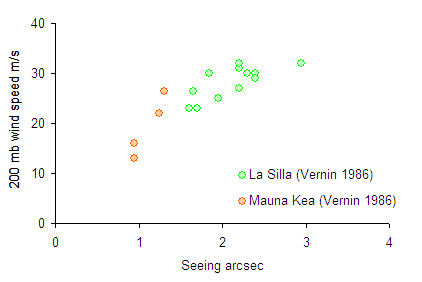It is a well known among amateur (and professional?) astronomers that the jet stream is important for the seeing. Or is it? What evidence exists to support this important role of the jet stream? Vernin (1986) reported a good correlation between the wind speed at the 200 milibar level (the jet stream) and seeing at Mauna Kea and La Silla, and suggested that a jet stream speed of less than 20 meters/second was a requirement for good seeing.
Later studies have however cast serious doubt on this; a large quantity of data from various observatories shows a poor correlation between seeing and jet stream speed. Good seeing can apparently be experienced even under a strong jet stream. The seeing estimates below were made using the DIMM method.
Data from Vernin 1986: Astronomical Site Selection - A New Meteorological Approach, Bounhir et al. 2009: High-altitude wind velocity at Oukaimeden observatory, Tokovinin et al. 2003: Statistics of turbulence profile at Cerro Tololo, and Garcia-Lorenzo et al. 2009: Adaptive optics parameters connection to wind speed at the Teide observatory.
My own seeing estimates also show only a slight correlation (actually non-significant; P=0.06) relationship between the seeing (visually estimated, Pickering scale) and the speed of the jet stream.
There does however seem to be a relation between the coherence time (the “speed” of the seeing) and the jet stream speed.
The above graphs, modified from Garcia-Lorenzo et al. 2009, indicate the necessary exposure time to “freeze” the seeing at a given wind speed at the 200 mbar level (top) and at ground level (bottom). The corresponding frame rate for a video capture is shown on the right Y-axis. The correlation is not high, but in general higher wind speeds, both at ground level and in the jet stream, correlate with shorter coherence time. To match the shorter coherence times at high wind speeds, frame rates above 200 frames/sec (fps) may be necessary. The popular Imaging Source cameras using the Sony ICX098BL chip can achieve only 30 fps without artefacts. Their new model with the Sony ICX618ALA chip can reach 60 fps. The Flea3 from Point Grey can reach 120 fps (possibly with artefacts), or more with ROI (Region Of Interest). The very short exposure times that come with such high frame rates can only be used on a very bright target (e.g. Venus, Mars, the Sun), or with a telescope setup with a low effective focal ratio.
The wind throughout the whole column of air affects the seeing, as this profile of turbulence shows:
As we see the wind at ground level is more important than the jet stream (notice the logarithmic scale).





No comments:
Post a Comment